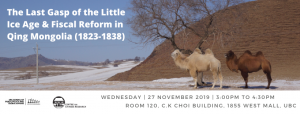
Sam H. Bass
PhD Candidate, Departments of History and Central Eurasian Studies, Indiana University
ABSTRACT
The Mongolian nobility, the descendants of Chinggis Khan, enjoyed exemptions from tax and compulsory labor during the Qing dynasty (1691-1911) until the mid-nineteenth century, when those privileges diminished. Scholars have correlated this erosion of privilege to increasing debts owed by noblemen and officials to Chinese merchant houses. However, based on archival research about disaster and poverty relief efforts in Qing Mongolia during the nineteenth century the crucial elements appear to be environmental factors, poverty alleviation efforts, and anti-clericalism.
The twenty years between 1830-1850 were the coldest in Mongolia in the last 1,000 years, according to dendrological paleoclimatic data. During those two decades, the Mongolian countryside was ravaged by winter storms and droughts; as a result of repeated livestock die-offs, many districts were unable to meet tax and labor quotas. Unlike the Chinese parts of the Qing empire, where the government opened grain reserves to relieve famine and offset inflated prices during natural disaster, in Outer Mongolia the government moved common herders, livestock, and goods from wealthier districts to destitute ones, a process they called “equalizing dues” (Mo. alba tegsidkekü). Because of the prolonged period of cold and dry weather, equalization was insufficient to meet the Qing’s fiscal demands in the 1820s, leading to an emergency decision to tax the nobility directly. The direct taxation of the nobility exposed to Qing auditors the means by which wealth had been sheltered in Outer Mongolia; importantly, the Qing court perceived Mongolian Buddhist ecclesiastical estates as sites of wealth concealment and labor runoff, and in 1838 prescribed enrollment in Buddhist estates to a narrow range of people. These policy shifts, triggered by abnormal climatic conditions, had long-lasting consequences for Mongolian society.
This presentation draws on Mongolian, Manchu, and Chinese source materials to explain this process and contextualize the findings in terms of their significance to late imperial Chinese history and Mongolian studies. This presentation will be of interest to students of early modern Chinese and Inner Asian history as well as pastoral-nomadic and Mongolian studies.